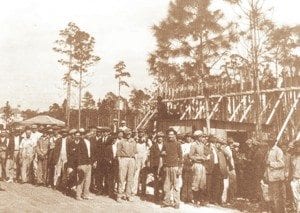 The development and building of Coral Gables is owed in great part to the skill and labor of Bahamian immigrants to South Florida. These early settlers brought two unique skills to the area: first, the agricultural practices of the islands were applied in Florida and helped demonstrate that despite the abundance of coral rock, it was feasible to convert the rocky country into rich farmland; second, many of the Bahamian settlers were skilled craftsmen – masons and builders who knew how to work with the coral rock.
The development and building of Coral Gables is owed in great part to the skill and labor of Bahamian immigrants to South Florida. These early settlers brought two unique skills to the area: first, the agricultural practices of the islands were applied in Florida and helped demonstrate that despite the abundance of coral rock, it was feasible to convert the rocky country into rich farmland; second, many of the Bahamian settlers were skilled craftsmen – masons and builders who knew how to work with the coral rock.
City founder George Merrick himself credited the Bahamian settlers with a lot more than their labor. “In the Bahamas,” he said, “there is the same coral rock; and the Bahamians knew how to plant on it; and how to use it; and they knew too that all kinds of tropical trees would grow and thrive on this rock. They, too, had a vital influence upon our civilization in bringing in their own commonly used trees, vegetables, and fruits.”
Merrick also acknowledged the Bahamian settlers’ expertise in masonry. They knew how to make lime mortar from coral rock and how to use it for construction. Indeed, their skill and labor is reflected today in many of the buildings and public works in the City of Coral Gables.
Many of these pioneer families of the early 1900s settled in the areas in Coral Gables known today as the MacFarlane-Homestead and Golden Gate subdivisions, bounded by US1 on the North, Coconut Grove on the East, LeJeune Road on the West and Grant Avenue on the South. Their architecture is primarily in the Bahamian bungalow and shotgun wood-frame vernacular style, and they remain today as two of the few physically intact neighborhoods of that time, with many new generations of pioneer families still residing there.
One of the distinctive characteristics of the two subdivisions is that a great number of their residents are descendants of their original pioneer families, including the Ramsay, Hopkins, Williams, Gibson, Wildgoose, Cooper, Tucker and Moore families. Some of the area’s notable early settlers include land developers E.W.F. Stirrup and George Allen; Mrs. Frances S. Tucker, a long-time educator, and Nellie B. Moore, a muchloved resident for whom an area park is named. The MacFarlane-Homestead district was noted as an exceptional historic reminder of the Bahamian settlers’ contribution through its listing in the National Register of Historic Places.






